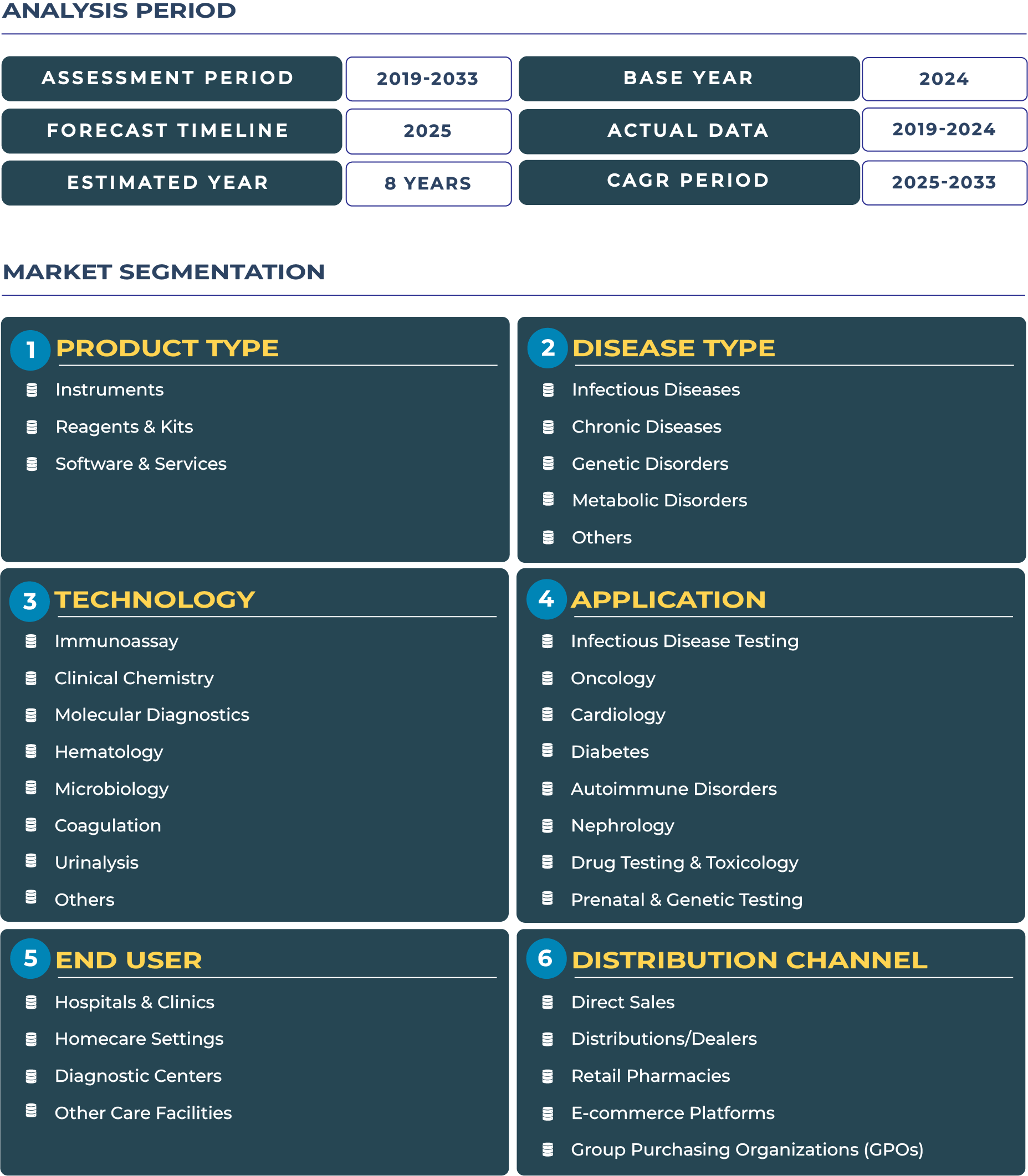Saudi Arabia In-vitro Diagnostic Market Outlook: Vision 2030 Reforms Fueling Diagnostic Transformation
Open with Saudi’s Vision 2030 driving healthcare infrastructure expansion: Saudi Arabia stands at the forefront of healthcare transformation in the Middle East, propelled by the Vision 2030 framework that aims to diversify its economy and enhance public health infrastructure. This national vision has positioned the Kingdom as a regional hub for advanced medical technology, including in-vitro diagnostics (IVD). With healthcare modernization at the core of its reform agenda, Saudi Arabia’s IVD market is witnessing structural growth supported by robust government investments, smart hospital projects, and technology localization initiatives.
The Saudi Arabia In-vitro Diagnostic Market is projected to reach USD 660.5 million by 2033 from an estimated USD 500.7 million in 2025. This growth trajectory is underpinned by rising demand for molecular testing, point-of-care diagnostics, and automated laboratory systems across tertiary hospitals and private laboratories. The country’s healthcare digitization, backed by the Ministry of Health (MOH), continues to facilitate adoption of advanced diagnostic systems and AI-enabled analytical platforms, creating a sophisticated IVD ecosystem aligned with Vision 2030’s objective of enhancing preventive healthcare and operational efficiency.
Vision 2030 Reforms Catalyzing Diagnostic Precision and Localization
Saudi Arabia’s Vision 2030 reform blueprint serves as the foundational driver transforming the country’s healthcare infrastructure and, consequently, the in-vitro diagnostic landscape. Government-backed mega hospital projects, such as the New Eastern Health Cluster and Riyadh’s upcoming smart medical cities, are fostering demand for high-end diagnostic instruments, reagents, and integrated laboratory management software. The transition from import dependency to local production of test kits and analyzers is gaining momentum under the Saudi Food and Drug Authority (SFDA)’s regulatory guidance, improving self-reliance and ensuring supply chain stability.
The increasing prevalence of chronic diseases such as diabetes, cardiovascular ailments, and cancer, coupled with expanding genomic and molecular testing programs, continues to accelerate the need for precision diagnostic solutions. Private healthcare operators are integrating real-time data platforms to enhance test turnaround times, while public institutions are embedding automation and AI analytics to optimize clinical workflows. Collectively, these advancements underscore a maturing IVD market that mirrors the Kingdom’s broader shift towards value-based healthcare delivery.
Drivers & Restraints: Decoding Market Growth Dynamics in Saudi Arabia’s IVD Ecosystem
Government-led hospital investments and healthcare modernization drive IVD expansion
Large public hospital capital expenditure under Vision 2030 has emerged as a core growth enabler for the Saudi Arabia in-vitro diagnostic industry. The expansion of facilities such as King Abdullah Medical City and the King Salman Medical City has amplified the need for fully automated diagnostic analyzers and molecular testing systems. Additionally, the government’s vision-driven healthcare diversification plan prioritizes advanced diagnostics as a cornerstone of personalized medicine, ensuring continuous demand for high-accuracy testing systems and reagent supply networks. The surge in elective and trauma-related procedures has further increased reliance on rapid testing platforms, supporting market expansion across public and private healthcare segments.
Localization mandates and workforce challenges restrain market scalability
While the Saudi IVD market benefits from ambitious national reforms, certain challenges persist. Localization requirements under the Saudi Content and Localization Program demand that global IVD companies establish local manufacturing, partnerships, or technology transfer initiatives to maintain regulatory compliance. These obligations, though beneficial for long-term ecosystem resilience, often slow immediate market entry and procurement processes. Additionally, the limited availability of specialized biomedical engineers and clinical lab professionals presents operational constraints, particularly for advanced testing modalities. Prolonged procurement cycles and increasing cost scrutiny from both public and private payers further moderate growth momentum.
Trends & Opportunities: Saudi Arabia’s Diagnostic Market Poised for Technological Elevation
Nationalization and private sector integration reshape the diagnostic supply landscape
A pivotal trend redefining the Saudi Arabia in-vitro diagnostic landscape is the nationalization of procurement systems. The consolidation of public hospital purchasing under centralized health clusters ensures consistency and quality but simultaneously demands higher compliance standards from suppliers. The growing participation of private providers, such as Dr. Sulaiman Al Habib Medical Group and Saudi German Health, in specialist diagnostics is driving competitive differentiation through premium service offerings and adoption of high-throughput analyzers. Moreover, national laboratory initiatives are emphasizing data interoperability, laying the groundwork for a connected diagnostic ecosystem.
Emerging opportunities in localization partnerships and managed diagnostic service models
Saudi Arabia’s localization drive presents notable opportunities for international diagnostic manufacturers to establish joint ventures and local assembly facilities. Global players such as Siemens Healthineers and Roche Diagnostics are increasingly engaging in managed service contracts with Saudi hospitals, offering comprehensive laboratory operation solutions, maintenance, and reagent supply under fixed-cost models. Additionally, the rise of diagnostic training academies, supported by the Ministry of Human Resources and Social Development, is cultivating a skilled workforce capable of operating advanced testing systems, which further strengthens the country’s clinical diagnostics capacity.
Competitive Landscape: Localization and Strategic Partnerships Redefining Market Leadership
The Saudi Arabia in-vitro diagnostic market is characterized by a blend of global innovation and domestic collaboration. Companies such as Siemens Healthineers, Roche Diagnostics, Abbott Laboratories, and local distributors like Al Borg Diagnostics are leading technology integration efforts. Recent developments include the establishment of localized reagent packaging lines in Riyadh and collaborative R&D initiatives between multinational corporations and Saudi universities to advance precision medicine diagnostics. Strategic moves such as forming managed service partnerships and licensing agreements are common, ensuring alignment with national localization targets. These strategies reflect a deliberate shift from simple product distribution to long-term ecosystem participation, strengthening the Kingdom’s diagnostic sovereignty and resilience.







